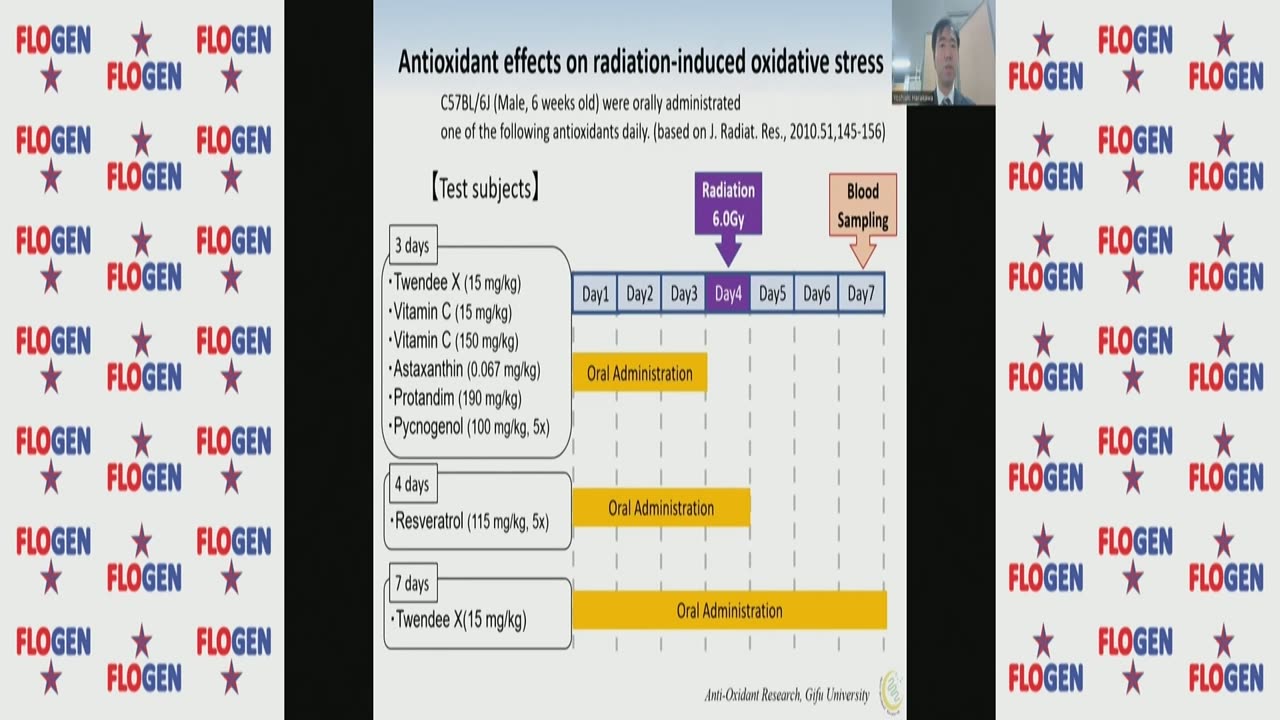Premium Only Content

Prof. Yoshiaki Harakawa #2 @ FLOGEN SIPS 2022 Yoshikawa Intl. Symposium on Oxidative Stress
FLOGEN SIPS 2022: Yoshikawa International Symposium on Oxidative Stress for Sustainable Development of Human Beings (2nd international Symposium)
Presenter:
Prof. Yoshiaki Harakawa, Division of Anti-oxidant Research, Gifu University, Gifu, Japan
Title:
Effect of antioxidant Twendee X on radiation-induced oxidative stress
Abstract
It is known that when a living organism is exposed to radiation, water molecules in the body ionize, producing reactive oxygen species, which in turn cause inflammation.
Twendee X (TWX) is an antioxidant supplement consisting of eight ingredients (coenzyme Q10, vitamin C, vitamin B2, niacin, L-cystine, succinic acid, fumaric acid, and L-glutamine), and in 2019, Japan Society for Dementia Prevention-led randomized and double-blind clinical trials certified it as effective in preventing dementia. In recent years, many products claiming antioxidant effects have become available due to the anti-aging boom. Therefore, we investigated whether TWX and other substances can inhibit oxidative stress generated by radiation.
[Methods]
Mice (C57BL/6J, 6 weeks old, male) were orally administered the test substance TWX (15 mg/kg) for 3 days at 24-hour intervals, irradiated with 6 Gy of radiation on the fourth day, and blood samples were taken 72 hours later, and survival was observed as is. Vitamin C (15 and 150 mg/kg), Resveratrol (115 mg/kg), Astaxanthin (0.067 mg/kg), Protandim (190 mg/kg), and Pycnogenol (100mg/kg) were used as antioxidants for comparison to TWX. Serum hydroperoxide level was measured as blood oxidative stress (d-ROMs test).
[Results]
The oxidative stress level in mice increased with radiation dose, and a significant increase was observed from 4 Gy onward compared to the control group. The survival rate decreased from the 20th day of irradiation at 6 Gy, and all mice were confirmed dead in 14 days of irradiation at 7 Gy.
In contrast, the increased d-ROMs test value by radiation was reduced by one third in the group treated with TWX (15 mg/kg) before irradiation for 3 days (t-test, p less than 0.05), and the oxidative stress level was lower in the group treated for 7 days than in normal mice. In addition, the administration of TWX suppressed radiation-induced deaths.
Vitamin C (150 mg/kg) and astaxanthin (0.067 mg/kg) treatment groups reduced d-ROMs test values, but the difference was not statistically significant. The low concentrations of vitamin C (15 mg/kg), Pycnogenol, and Protandim did not change the d-ROMs test values compared to the control group, and for the Resveratrol group, the d-ROMs test values increased compared to the control group.
[Discussion]
TWX significantly reduced radiation-induced oxidative stress at a small dose of 15 mg/kg, while other comparators showed no reduction. In particular, the resveratrol-treated group showed elevated oxidative stress. Resveratrol is a polyphenol that is known to have antioxidant properties, however, high intake of a single polyphenol may have resulted in an increase in oxidative stress. TWX is composed only of substances that exist in the human body, and a small dose of TWX showed high antioxidant activity. This may have reduced inflammation caused by oxidative stress, ultimately leading to an increase in survival rate. The antioxidant potential of TWX in this experiment suggests the possibility of future applications for various oxidative stress-related diseases.
References:
[1] Tadokoro K, et al. Clinical Benefits of Antioxidative Supplement Twendee X for Mild Cognitive Impairment: A Multicenter, Randomized, Double-Blind, and Placebo-Controlled Prospective Interventional Study. J Alzheimers Dis. 2019;71(3):1063-1069.
[2] Yamamoto T, Kinoshita M, Shinomiya N, Hiroi S, Sugasawa H, Matsushita Y, Majima T, Saitoh D, Seki S. Pretreatment with ascorbic acid prevents lethal gastrointestinal syndrome in mice receiving a massive amount of radiation. J. Radiat. Res., 2010. 51, 145-156.
[3] Yoshikawa T, et al. [All about Free Radicals – from Health to Environmental Pollution -] Kasseisanso , Free Radical no subete – Kennkou kara kannkyouosen made – (in Japanese), Maruzen Publishing, 2000, 78-79.
[4] Seki Y. [Evaluation of total oxidative stress by d-ROMs testing] d-ROMs test niyoru sankasutoresu sougouhyouka (in Japanese). Seibutsu siryou bunseki (Journal of analytical bio-science), 2010. 32(4), 301-306.
-
 2:08:48
2:08:48
TheSaltyCracker
7 hours agoLefty Grifters Go MAGA ReeEEeE Stream 12-22-24
145K391 -
 1:15:40
1:15:40
Man in America
10 hours agoThe DISTURBING Truth: How Seed Oils, the Vatican, and Procter & Gamble Are Connected w/ Dan Lyons
47.9K38 -
 6:46:07
6:46:07
Rance's Gaming Corner
12 hours agoTime for some RUMBLE FPS!! Get in here.. w/Fragniac
135K1 -
 1:30:48
1:30:48
Josh Pate's College Football Show
11 hours ago $4.99 earnedCFP Reaction Special | Early Quarterfinal Thoughts | Transfer Portal Intel | Fixing The Playoff
34.3K -
 23:55
23:55
CartierFamily
3 days agoElon & Vivek TRIGGER Congress as DOGE SHUTS DOWN Government
120K102 -
 5:43:44
5:43:44
Scammer Payback
2 days agoCalling Scammers Live
189K26 -
 18:38
18:38
VSiNLive
2 days agoProfessional Gambler Steve Fezzik LOVES this UNDERVALUED Point Spread!
140K17 -
 LIVE
LIVE
Right Side Broadcasting Network
10 days agoLIVE REPLAY: President Donald J. Trump Keynotes TPUSA’s AmFest 2024 Conference - 12/22/24
2,878 watching -
 4:31
4:31
CoachTY
1 day ago $28.15 earnedCOINBASE AND DESCI !!!!
184K11 -
 10:02
10:02
MichaelBisping
1 day agoBISPING: "Was FURY ROBBED?!" | Oleksandr Usyk vs Tyson Fury 2 INSTANT REACTION
104K14